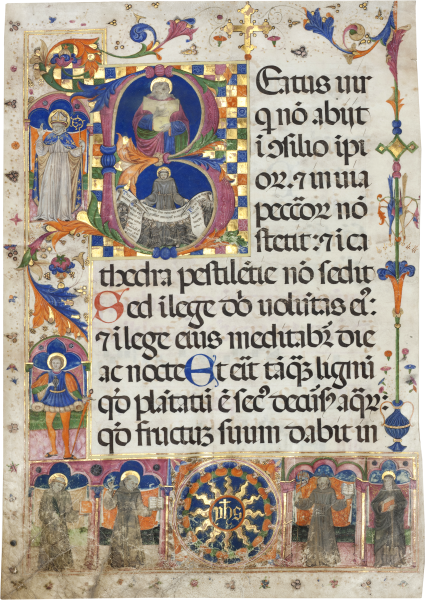


Master of the Graduals of San Salvatore in Pavia (Giovanni Siro Cattaneo?)
, Italy, Pavia, c. 1490Master of the Graduals of San Salvatore in Pavia (Giovanni Siro Cattaneo?)
Description
Decorating an initial ‘E,’ this miniature presents a visceral scene of the Massacre of the Innocents from the nativity narrative of the Gospel of Matthew (2:16-18). While paintings of the Massacre typically depict marauding groups of soldiers directed by a monstrous King Herod, the artist here has focused on a single legionnaire who cradles a naked child in his arms. Their intimate pose is disrupted with a jarring act of violence, and the tragedy is expressed in a mixture of pain and tenderness on the soldier’s face. The immediacy of the scene is heightened by the crossbar of the ‘E,’ cleverly tucked behind the figures, which thrusts both soldier and child forward into the space of the viewer. Probably cut from a Gradual, the initial may once have prefaced the Introit Exore infantium, for the Feast of the Holy Innocents celebrated on December 28.
The initial is painted by the Master of the Graduals of San Salvatore in Pavia, who was active at the end of the fifteenth and the beginning of the sixteenth century and is named after his contributions to two Choir Books in Pavia (Biblioteca d'arte dei Musei civici, MSS 544 and 545). His career has been most thoroughly studied by Pier Luigi Mulas. Manuscript paintings by this artist share morphological similarities in the decoration, such as the rich pink hue of the initial decorated with scalloped white tracery set against a highly burnished gold ground. The chiseled faces, blond curly hair, and mannered hands of the figures are also distinctive features of our artist, who continued the Gothic tradition of Belbello da Pavia into the beginning of the sixteenth century and collaborated with artists more typical of the high Renaissance such as Matteo da Milano. More precisely, Pier Luigi Mulas draws attention to another Massacre of the Innocents, comparable for both iconography and composition of our miniature, which he attributes to the same hand (Fig. 1). This painting whose current whereabouts remain unknown (though it is documented through a photograph at the Zeri Foundation in Bologna, Italy), may have been originally inserted in the predella of the Bottigella altarpiece (Pinacoteca Malaspina, Pavia). It is possibly attributable to the so-called 'Master Collaborator of the Bottigella Altarpiece,' who has recently been identified as Giovanni Siro Cattaneo da Brignano, painter and gilder.
The painting is in excellent condition with only mild tarnishing to the gold leaf. Extant initials and full pages by this artist still need to be assembled to identify a parent manuscript or manuscripts. Three initials all possibly from the same manuscript were in Ferrini and Fogg, Medieval & Renaissance Miniature Painting, 1988, nos. 15-17 (Figs. 2 and 3). Full sheets by the artist were in the Robert Lehman Collection (see Pia Palladino, Treasures of a Lost Art, New York 2003-2004, no. 61, pp.127-128); in the Fondazione Giorgio Cini in Venice (see Mulas in Massimo Medico and Federica Toniolo, Le Miniature de la Fondazione Giorgio Cini, Milan [2016], nos. 178a-c); and in the Kupferstichkabinett in Berlin, Cod. 6220 (see Beatrice Alai, Le Miniature italiane del Kupferstichkabinett di Berlino, Florence, 2019, pp. 306-307). Two volumes of a Ferial Psalter, one in a Private Collection and one in Boston, the latter missing leaves (Boston Public Library MS pf Med. 97), are partially by his hand prepared for the Benedictine Abbey of San Sisto, Piacenza, Italy, c. 1495 (see Milvia Bolatti in Jeffrey Hamburger, William Stoneman, et al., Beyond Words Illuminated Manuscripts in Boston Collections, Boston, 2016, no. 226). The monastery of San Salvatore in Pavia was affiliated with congregation of Santa Giustina in Padua, a leading center of monastic reform that resulted in the production of many richly illuminated service books by some of the most sought-after artists of the period.
Literature
For comparisons see:
Hindman, Sandra. Medieval & Renaissance Miniature Painting, London and Tokyo, 1988, pp. 30-35, nos. 15, 16, 17.
Mulas, Pier Luigi. “Le Maître des Graduels de San Salvatore de Pavie,” in Mara Hofmann and Caroline Zoehl, eds., Quand la peinture était dans les livres, Turnhout, 2007, pp. 223-33, esp. p. 223.
Idem. “I Corali di San Sisto,” in Milvia Bollati, ed., I corali benedettini di San Sisto a Piacenza, Bologna, 2011, pp. 45-66.
Idem. “La miniatura pavese del Rinascimento e la pittura contemporanea,” in Rivista di storia delle Miniatura, 27, 2023, pp. 119-126.
